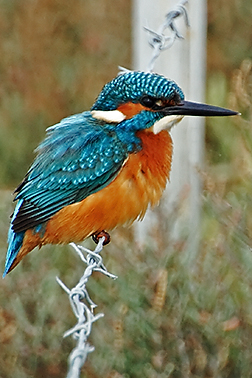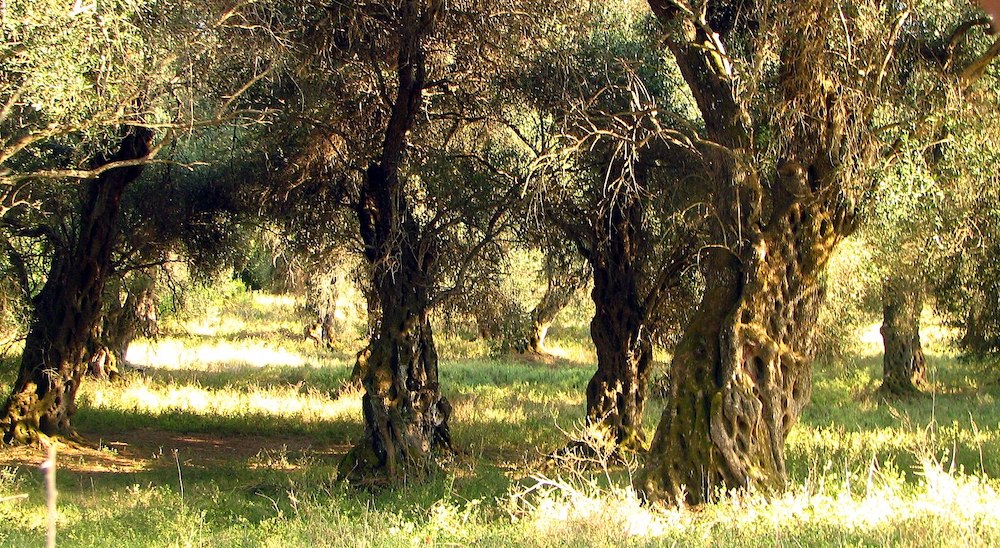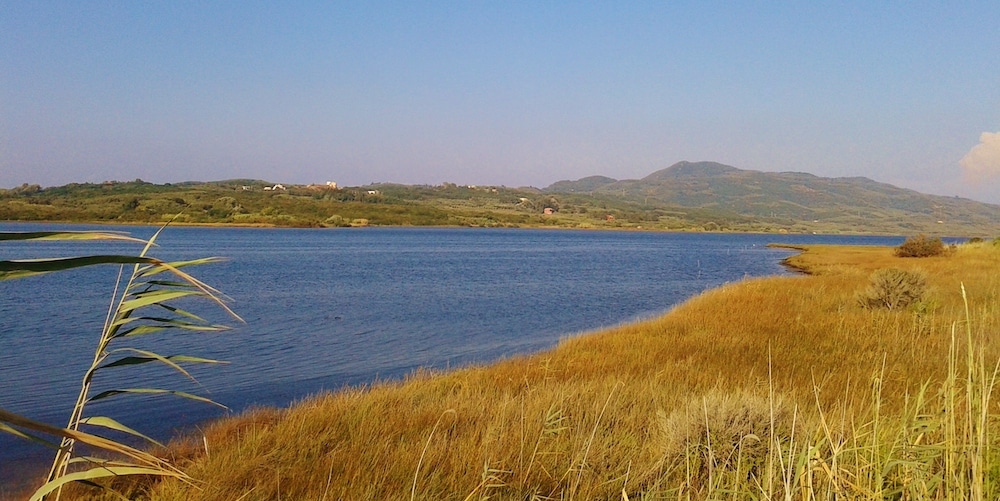Corfu

Corfu is a Greek island in the Ionian Sea covering roughly 600 km2, (236 square miles) with a population of about 100,000 people. Its northeastern coastline lies off the coast of Sarandë, Albania, from which it is separated by straits varying in width from three to twenty-three kilometres km, while the southeast side of the island lies off the coast of Thesprotia, Greece. It is the second largest of the Ionian Islands and, including its small satellite islands, forms the edge of the northwestern frontier of Greece. The capital and principal city of the island and seat of the municipality is also named Corfu, it has a population of c. 34,000 people. Corfu is home to the Ionian University.
Two high and well-defined ranges divide the island into three districts, of which the northern is mountainous, the central undulating, and the southern low-lying. The more important of the two ranges, that of Pantokrator stretches east and west from Cape Falacro to Cape Psaromita, and attains its greatest elevation in the summit of the same name. The second range culminates in the mountain of Santi Jeca, or Santa Decca or the Ten Saints. The whole island, composed as it is of various limestone formations, presents great diversity of surface, and views from more elevated spots are magnificent. Beaches are found in Agios Gordis, the Korission lagoon, Agios Georgios, Marathia, Kassiopi, Sidari, Palaiokastritsa and many others.
Corfu is located near the Kefalonia geological fault formation; earthquakes have occurred. Corfu city and countryside have not lost the traditional architecture from the 16th century. The coastline spans 217 kilometres (135 miles) including capes; its highest point is Mount Pantokrator 2,972 feet; and the second Stravoskiadi, at 2,785 feet. The full extent of capes and promontories take in Agia Aikaterini, Drastis to the north, Lefkimmi and Asprokavos to the southeast, and Megachoro to the south. Two islands are also to be found at a middle point of Gouvia and Corfu Bay, which extends across much of the eastern shore of the island; are known as Lazareto and Ptychia (or Vido).

Corfu Olive Grove – ©Bogdan Giuşcă CC BY-SA 2.5 via Wikimedia Commons
Cultivation is found across the island with olive, pomegranate, fig groves and vineyards along with all the fruit trees known in southern Europe, with addition of the banana, kumquat, loquat and prickly pear. When undisturbed by cultivation, the myrtle, arbutus, bay and holm oak form a rich brushwood, and the minor flora of the island are extensive. Its fauna is similar to that of the opposite mainland. Corfu has a hot-summer Mediterranean climate featuring hot, dry summers and mild to cool, and very rainy winters, which are much wetter than other Greek islands.
Eight species of amphibians and 31 species of reptiles live or have been recorded on and around Corfu. 40 species of mammal have been recorded including feral populations of some exotics like Indian Crested Porcupine and Raccoon. The islands is also particularly good for butterflies with more than 75 species recorded.
Birding Corfu
Corfu’s mild all-year round climate and because it is one of the greenest island in the med with a number of lagoons it does have a rich avifauna. Unfortunately, of course, they have to avoid the ravages of hunters. Nevertheless, around 300 species have been recorded. High elevations and wetlands are the best places to bird but scrubland, olive groves, orchards and cultivated areas do hold birds if you are quiet and patient.
Arriving by plane the first wetland you will see is by the airport itself which is built in the Chalikopoulou lagoon, a small ecosystem in its own right. This is a sea water lagoon but has several streams that trickle fresh water almost all year round make is a very diverse habitat for wildlife. It has recently been designated as a reserve.

Korission – ©ANDRIANA KARBOUNI CC BY-SA 4.0 via Wikimedia Commons
There are two much larger lagoons the Korission in the south west and Andinoni in the north east, but the greatest magnet for bird life is the great salt flat in Lefkimmi and its disused salt pans.
-
Lake Halikiopoulos
InformationSatellite ViewNow designated as a nature reserve -
Lake Korision
InformationSatellite View -
Lefkimi Salt Pans
InformationSatellite ViewWaders, terns including Whiskered and Black and heron species including Purple Heron, Spoonbills & Squacco Heron. Surrounding area good for Tawny Pipit. -
Pantokrator Mountain
Satellite ViewGood for raptors and Rock Nuthatch, Blue Rock Thrush, Cirl Bunting, Black-eared Wheatear and Black Redstart…
-
Number of bird species: 314
(As at June 2024)
-
Avibase
PDF ChecklistThis checklist includes all bird species found in Corfu (former) , based on the best information available at this time. It is based on a wide variety of sources that I collated over many years. I am pleased to offer these checklists as a service to birdwatchers. If you find any error, please do not hesitate to report them. -
eBird
PDF ChecklistThis checklist is generated with data from eBird (ebird.org), a global database of bird sightings from birders like you. If you enjoy this checklist, please consider contributing your sightings to eBird. It is 100% free to take part, and your observations will help support birders, researchers, and conservationists worldwide.
-
naturetrek
Tour OperatorA relaxing 8-day holiday to the beautiful Ionian island of Corfu.
-
2014 [09 September] - Paul Dykta
ReportAll our birding was done on foot as neither of us drive, saying that we were out every day, thunder storms or not. We did three trips to a nearby salt water lake/lagoon called lake Korisson, although you couldn't get too close to it from the south on foot, you could certainly get good views. The rest of our time out was spent walking through olive trees(more like forests than groves)and round agricultural land. In fact we approached the lake by three different routes, one of them across large sand dunes. -
2016 [05 May] - Jon Hornbuckle - Corfu, Cyprus, Macedonia & Albania
ReportSyndy and I spent 3 weeks sight-seeing and birding in Cyprus, Macedonia, Albania and Corfu (Greece). I had only been to mainland Greece and Lesbos before, so it was 3 new countries for me.
-
Corfu Wildlife
ArticleDue to the Corfiots love of hunting most species of birds on the island shun human contact and might not be as abundant as in other parts of Europe therefore you have to work hard to observe them -
Nature Conservancy in Michigan
ArticleThose of you familiar with Gerald Durrell's "My Family and Other Animals" will already have an idea of the diversity of flora and fauna in Corfu. For those keen to observe the beauty of nature at close quarters, the island is a naturalist's paradise. Whether you are a keen botanist, ornithologist, zoologist or photographer, Corfu has something for you -
St Spiridon Nature Reserve
VideoNature reserve, North Corfu Greece 2016. Captured by Kassiopi Corfu TV. Stunning St Spiridon Lake and Nature reserve.
